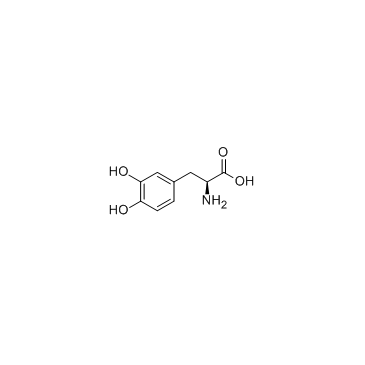左旋多巴

左旋多巴结构式

|
常用名 | 左旋多巴 | 英文名 | Levodopa |
|---|---|---|---|---|
| CAS号 | 59-92-7 | 分子量 | 197.188 | |
| 密度 | 1.5±0.1 g/cm3 | 沸点 | 448.4±45.0 °C at 760 mmHg | |
| 分子式 | C9H11NO4 | 熔点 | 276-278 °C(lit.) | |
| MSDS | 中文版 美版 | 闪点 | 225.0±28.7 °C | |
| 符号 |

GHS07 |
信号词 | Warning |
|
Insights from reconstitution reactions of COPII vesicle formation using pure components and low mechanical perturbation.
Biol. Chem. 395(7-8) , 801-12, (2014) As shape transformations of membranes are vital for intracellular trafficking, it is crucial to understand both the mechanics and the biochemistry of these processes. The interplay of these two factors constitutes an experimental challenge, however, because b... |
|
|
Activation of PPAR gamma receptors reduces levodopa-induced dyskinesias in 6-OHDA-lesioned rats.
Neurobiol. Dis. 74 , 295-304, (2015) Long-term administration of l-3,4-dihydroxyphenylalanine (levodopa), the mainstay treatment for Parkinson's disease (PD), is accompanied by fluctuations in its duration of action and motor complications (dyskinesia) that dramatically affect the quality of lif... |
|
|
Brexpiprazole I: in vitro and in vivo characterization of a novel serotonin-dopamine activity modulator.
J. Pharmacol. Exp. Ther. 350(3) , 589-604, (2014) Brexpiprazole (OPC-34712, 7-{4-[4-(1-benzothiophen-4-yl)piperazin-1-yl]butoxy}quinolin-2(1H)-one) is a novel drug candidate in clinical development for psychiatric disorders with high affinity for serotonin, dopamine, and noradrenaline receptors. In particula... |
|
|
Inhibitory Effect of Dried Pomegranate Concentration Powder on Melanogenesis in B16F10 Melanoma Cells; Involvement of p38 and PKA Signaling Pathways.
Int. J. Mol. Sci. 16 , 24219-42, (2015) Plants rich in antioxidant substances may be useful for preventing skin aging. Pomegranates, containing flavonoids and other polyphenolic compounds, are widely consumed due to their beneficial properties. We examined the underlying mechanisms of dried pomegra... |
|
|
Cheminformatics analysis of assertions mined from literature that describe drug-induced liver injury in different species.
Chem. Res. Toxicol. 23 , 171-83, (2010) Drug-induced liver injury is one of the main causes of drug attrition. The ability to predict the liver effects of drug candidates from their chemical structures is critical to help guide experimental drug discovery projects toward safer medicines. In this st... |
|
|
Design, synthesis, and anti-melanogenic effects of (E)-2-benzoyl-3-(substituted phenyl)acrylonitriles.
Drug Des. Devel. Ther. 9 , 4259-68, (2015) Tyrosinase is the most prominent target for inhibitors of hyperpigmentation because it plays a critical role in melaninogenesis. Although many tyrosinase inhibitors have been identified, from both natural and synthetic sources, there remains a considerable de... |
|
|
Translating clinical findings into knowledge in drug safety evaluation--drug induced liver injury prediction system (DILIps).
J. Sci. Ind. Res. 65(10) , 808, (2006) Drug-induced liver injury (DILI) is a significant concern in drug development due to the poor concordance between preclinical and clinical findings of liver toxicity. We hypothesized that the DILI types (hepatotoxic side effects) seen in the clinic can be tra... |
|
|
Developing structure-activity relationships for the prediction of hepatotoxicity.
Chem. Res. Toxicol. 23 , 1215-22, (2010) Drug-induced liver injury is a major issue of concern and has led to the withdrawal of a significant number of marketed drugs. An understanding of structure-activity relationships (SARs) of chemicals can make a significant contribution to the identification o... |
|
|
A predictive ligand-based Bayesian model for human drug-induced liver injury.
Drug Metab. Dispos. 38 , 2302-8, (2010) Drug-induced liver injury (DILI) is one of the most important reasons for drug development failure at both preapproval and postapproval stages. There has been increased interest in developing predictive in vivo, in vitro, and in silico models to identify comp... |
|
|
Chemical genetics reveals a complex functional ground state of neural stem cells.
Nat. Chem. Biol. 3(5) , 268-273, (2007) The identification of self-renewing and multipotent neural stem cells (NSCs) in the mammalian brain holds promise for the treatment of neurological diseases and has yielded new insight into brain cancer. However, the complete repertoire of signaling pathways ... |